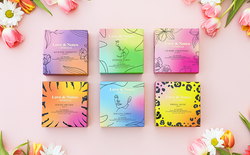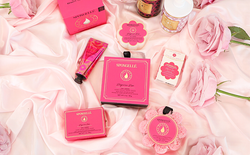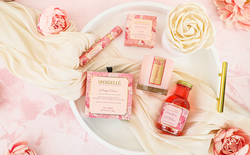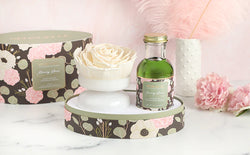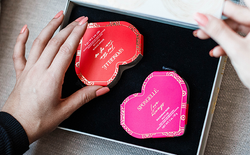Your skin is made up of several different layers. The top layer is the epidermis, which is responsible for protecting the body from environmental threats, injury, and infections. New skin cells are made in the lower level of the epidermis about every 28 to 30 days, pushing the older cells up to onto the outermost layer of your skin, leaving your exterior skin covered in a layer of dead skin cells.
In most cases, these cells can remove themselves from the top layer of your skin naturally, but depending on your skin type and age, this process can slow way down, especially over the course of your lifetime, leaving most of your skin covered in the lifeless cells.
These leftover cells create a dry, dull look to the skin and can cause blemishes and red spots if they get caught in the pores or follicles. Eventually, if the dead skin cells are not removed and the skin can't get nourished, it can lead to rough spots, ingrown hair, uneven skin tone, and blemished skin.
To achieve healthy, beautiful, braggable skin, this layer of dead skin cells must be regularly removed. The best way to attack this dry, dull skin? Exfoliation.
What Does Exfoliating Do?
Shedding dead skin cells is a natural part of life, but sometimes the skin cells don’t just fall off on their own. Instead, they can hang around on the surface, ultimately getting in the way of beautiful, radiant skin. This is where exfoliation is king.
Exfoliation removes unnecessary dead skin cells from the top layer of your skin with an abrasive to make way for the newly created skin cells to shine through. These new cells start out healthy and happy and ready to absorb any topical moisturizing products you throw their way, helping maintain soft, healthy skin.
Types of Exfoliants
There are two main types of exfoliants: mechanical and chemical.
Mechanical Exfoliants
Mechanical exfoliation removes the dead skin cells from the skin through applications of friction. Tools like brushes, sponges, and loofahs, when rubbed in a circular motion, create friction between the skin and the device. This process ultimately removes the dead skin cells from the top layer of your skin.
These friction tools are fantastic options for sloughing off the old cells, especially in hard to reach areas. However, some of the brushes or loofahs can have a hard scratchy, almost plastic surface that can scratch and damage the skin. It is best to look for a gentle sponge that is free from lacerating textures.
Body scrubs, also known as sugar or salt scrubs, are also popular physical exfoliants. Scrubs are one of the most popular forms of exfoliants because they come with a vast range of ingredients and can even be made at home using simple household staples found in the kitchen.
Body scrubs like these tend to have a gritty texture, and it is the particles themselves that, when rubbed into the skin, help remove the old cell layer. Body scrubs can sometimes be harsh on sensitive skin. It is best to look for a softer scrub that won’t scratch or rip your skin’s surface.
Quick-Step by Step Guide on How to Test Out and Use Physical Exfoliants
- Start with a clean arm. Using your favorite sponge, brush, or scrub, apply gentle pressure and use small circular motions to rub your arm’s entire length, making sure to avoid harsh scrubbing. Keep in mind that the goal is to gently and effectively remove dead skin cells. The harder you rub, the more you risk damaging your skin.
- Rinse all suds or scrub from your arm with lukewarm water. Hot water can irritate the skin.
- Pat dry using a fresh towel.
- Now, rub in a lovely silky, body butter like our popular tuberose scented soufflé into the skin to lock moisture into those beautiful new skin cells.
Chemical Exfoliants
Chemical exfoliants use enzymes and acids to break down the old skin cells. They are available in various skincare products like medicated face washes, treatment gels, peels, or even a spray.
Quick-Step by Step Guide on How to Test out and use Chemical Exfoliants
- After cleansing, apply a chemical exfoliant to the skin using gentle circular, upward motions.
- If the product requires an absorption time, use a timer on your phone while waiting for the product to dry completely before moving on. Always rinse off any product with lukewarm water.
- Pat dry with a clean towel.
- Moisturize, moisturize, moisturize!
How Often You Should Exfoliate
The American Academy for Dermatology Association recommends choosing an exfoliating schedule and method that works for your skin type. If you aren’t sure which type of skin you have, consult a dermatologist before starting a routine.
With regular use, exfoliation can smooth and even out your skin texture. Exfoliation can also help increase cell turnover and naturally help fade the appearance of dark spots and hyperpigmentation. The exfoliation benefits are excellent, and there is absolutely nothing more lovely than beautiful, bouncy, hydrated skin year-round.
It is always best to start off slow with a new routine. Exfoliating every single day is not recommended, as it can actually remove the natural oils protecting your skin, and cause blemishes or even lasting damage. Try an exfoliant once a week to allow your skin to get used to the new treatment. After you have taken the time to see how your skin reacts. To the treatment, then you can add more exfoliation to your weekly routine.
Which Type of Exfoliation is Best
The best exfoliation method for you will be a combination. You need to consider which exfoliation method you enjoy the most and the type of skin you have. There are many products on the market for sensitive, normal, and even oily skin types. Finding one of these products that you like and works well with your skin will make a weekly exfoliating routine a breeze.
We suggest you invest in a gentle exfoliating sponge to get started. Try one of our top-selling body washed infused boxed flowers. A body wash infused sponge can take the guesswork out of which product to buy. These sponges make starting a new routine accessible and successful by having an all in one tool that does the work for you.
A few great options of body wash infused buffers or sponges are:
- Top Seller Black Orchid - seductive and exotic
- Bourbon Vanilla Body Buffer - warm and cozy and sweet
- Papaya Yuzu - caramel citrus
The Dangers of Over-Exfoliation
It is all about the delicate balance with exfoliation. Frequency and exfoliating pressure do not improve your end results. Skin is porous and soft, and we can damage our skin’s built-in protective layer that keeps moisture locked into our bodies by over-exfoliating. It is best to be gentle and take your time with the new habit for it to be productive.
Exfoliating too harshly or too frequently will cause micro-tears on the skin’s surface. Not only are these perfect places for germs and infection to hide and fester, but the scrapes and tears also allow your skin’s much-needed moisture to escape from the under layers of the skin.
If you see any of these indications after over-exfoliating, stop all exfoliation and schedule a visit with your dermatologist.
Indicators of over-exfoliating:
- Redness
- Excessive dryness
- Inflammation
- Intensifying rough patches
- Surface level infections
Exfoliation is an essential step in your weekly skincare routine. However, always make sure you follow a healthy, gentle routine that buffs up, not roughs up your beautiful skin. There are also times when you should take a break from your exfoliating routine to protect your skin.
Refrain from exfoliation if any of these occurs:
- When you have any kind of infection or an open wound around where you will be exfoliating, you do not want to damage the healing tissues. This is especially important if you use a scrub that has microscopic particles. These particles can become lodged in the damaged skin and irritate the healing tissue.
- When you have a sunburn, your skin is already damaged and irritated by UV rays. Exfoliating could be quite painful and cause more damage. Allow your skin to fully heal before continuing your routine.
- When you suffer from skin diseases like psoriasis or eczema, these areas can be incredibly sensitive and may not respond well to unmediated exfoliation. Always consult your dermatologist before starting a new skincare routine if you have one of these conditions.
結語
No matter which fragrance or tool you choose is right for you, starting a new routine, monitoring your skin’s reaction to this routine, and adjusting as necessary are going to be your first steps towards healthy, happy skin that glows from the inside out.
Start upping your skincare routine today with one of our body wash infused buffers. And, as an added bonus, use code BLOG20 for 20% off your first order!來源:
https://www.aad.org/public/everyday-care/skin-care-secrets/routine/safely-exfoliate-at-home
https://www.glamour.com/story/whats-the-deal-with-exfoliatin
https://www.huffpost.com/entry/signs-youre-overexfoliating_n_56019a36e4b00310edf8c802
